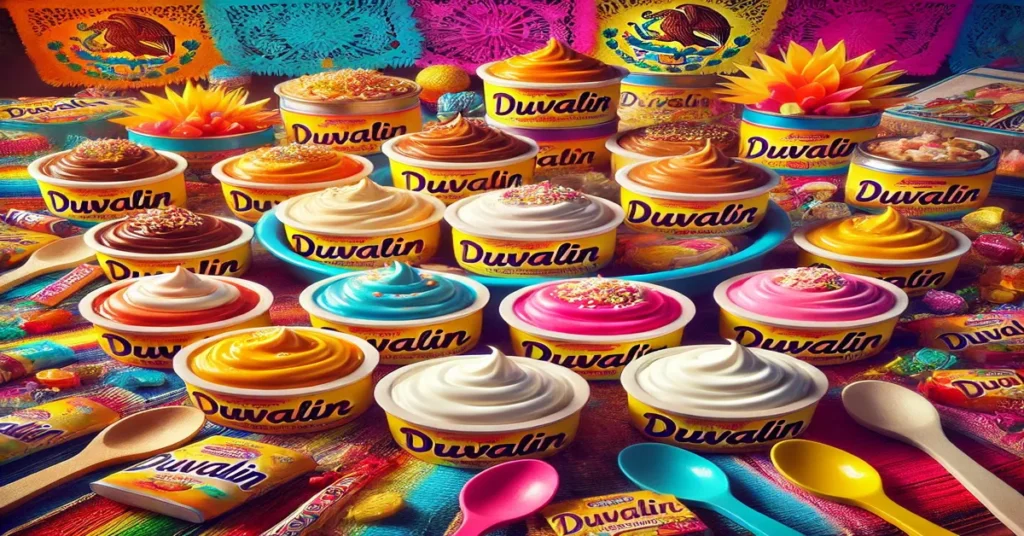When it comes to iconic sweets from Mexico, Duvalin stands out as one of the most recognizable and cherished treats. Known for its creamy texture, rich flavors, and vibrant packaging, Duvalin has become a symbol of nostalgia for many and a favorite among candy enthusiasts. Whether enjoyed by children after school or as a fun snack for adults, Duvalin has carved a special place in the hearts of consumers both in Mexico and beyond.
This article explores the history, flavors, cultural significance, and global appeal of Duvalin, along with its nutritional aspects and creative ways to enjoy this delightful treat.
What is Duvalin?
Duvalin is a creamy, non-sticky candy spread produced by Grupo Bimbo, a well-known Mexican multinational food company. It is categorized as a candy, though its texture and appearance resemble a dessert spread. Packaged in small, colorful containers with a mini spoon, Duv-alin is often enjoyed as a quick and satisfying snack.
The candy is popular for its variety of flavors, smooth consistency, and versatility—it can be eaten straight from the container, used as a topping, or included in creative recipes. Duvalin’s simple yet appealing nature makes it a staple in Mexican households and among those who love Mexican sweets.
The History of Duvalin
Duvalin was introduced in Mexico during the latter half of the 20th century by Ricolino, a subsidiary of Grupo Bimbo that specializes in candy and confectionery products. The candy was created with the idea of offering a convenient, creamy, and sweet snack that could be enjoyed anytime, anywhere.
As a product of Grupo Bimbo’s innovation, Duv-alin quickly became a hit among children and parents alike. Its small, portable packaging and unique flavors made it stand out from other candies on the market. Over time, the candy’s popularity grew, and it became a staple in corner stores, supermarkets, and candy shops across Mexico and Latin America.
With the increasing migration of Mexicans to other countries, particularly the United States, Duvalin’s found its way to international markets, where it continues to be embraced by fans of Mexican culture and cuisine.
Flavors of Duvalin
One of Duvalin’s key selling points is its variety of flavors. Each container often features a combination of two or more flavors swirled together, providing a fun and tasty experience. The most popular flavors include:
- Vanilla and Strawberry: This classic combination features creamy vanilla paired with sweet strawberry, offering a balanced and smooth taste.
- Hazelnut and Vanilla: A richer option, combining the nutty flavor of hazelnut with the sweetness of vanilla.
- Strawberry, Vanilla, and Chocolate: A tricolor option that combines three delicious flavors into one.
- Hazelnut and Chocolate: This duo is perfect for chocolate lovers, blending creamy hazelnut with rich cocoa flavor.
The variety of flavors allows Duvalin’s to cater to different taste preferences, making it a versatile treat for candy lovers of all ages.
Packaging and Presentation
Duvalin’s packaging is both simple and effective, making it instantly recognizable on store shelves. The candy comes in small, rectangular plastic containers with a peel-off foil lid. Each container includes a small, colorful plastic spoon, making it easy to enjoy the candy on the go.
The vibrant packaging often features fun graphics, bright colors, and playful branding that appeals to children and brings a sense of nostalgia to adults. This portable and user-friendly design has helped cement Duvalin’s as a beloved snack across generations.
Cultural Significance of Duvalin
1. A Nostalgic Treat
Duvalin holds a special place in the hearts of many who grew up in Mexico or in Mexican households abroad. For countless people, it is a symbol of childhood, evoking memories of trips to the local tienda (corner store) to pick up a small container of the candy.
2. Part of Mexican Candy Tradition
Mexico has a rich tradition of candies that range from spicy and tangy to sweet and creamy. Duv-alin belongs to the latter category, offering a smooth, sugary contrast to Mexico’s spicy tamarind and chili candies. It is often included in piñatas, gift bags, and celebrations, making it a staple for birthdays, holidays, and other special occasions.
3. A Global Icon
The growing influence of Mexican culture around the world has brought Duvalin’s to international audiences. It is now available in Mexican grocery stores, Latin markets, and online retailers in countries like the United States, Canada, and parts of Europe.
How to Enjoy Duvalin
While Duvalin is most commonly enjoyed straight from the container with its included spoon, there are several creative ways to savor this iconic treat:
1. As a Topping
- Spread Duvalin on pancakes, waffles, or toast for a sweet and creamy twist.
- Use it as a topping for ice cream, yogurt, or smoothies.
2. In Desserts
- Add Duvalin’s to cakes, cupcakes, or cookies as a flavorful filling or frosting.
- Use it in parfaits or as a layer in trifles.
3. As a Dip
- Pair Duvalin with pretzels, fruits, or crackers for a sweet-and-salty combination.
4. Frozen Treats
- Freeze small containers of Duvalin to create a cold, creamy snack during hot summer months.
- Swirl it into popsicles or frozen yogurt.
5. Creative Recipes
- Incorporate Duvalin’s into milkshakes or blended drinks for a unique flavor.
- Mix it with cream cheese or whipped cream to create a dip or spread for desserts.
These ideas showcase the versatility of Duvalin’s and its potential to enhance a wide range of snacks and desserts.
Nutritional Information
Duvalin’s is primarily a candy and, like most sweets, should be consumed in moderation. While it offers a delicious and satisfying treat, it is important to be mindful of its nutritional content.
Nutritional Breakdown (Approximate per 18g container):
- Calories: 90-100 kcal
- Total Fat: 4-5g (including saturated fat)
- Sugar: 9-10g
- Carbohydrates: 10-12g
- Protein: 1g
Duvalin’s contains sugar, vegetable oils, and artificial flavorings, which contribute to its creamy texture and sweet taste. While it is not a significant source of vitamins or minerals, it can be enjoyed as an occasional treat within a balanced diet.
Duvalin in the Global Market
Duvalin’s appeal has extended beyond Mexico, finding a place in the hearts and homes of international consumers. This global popularity can be attributed to several factors:
1. Cultural Influence
As Mexican culture and cuisine continue to spread worldwide, so too does the popularity of traditional candies like Duvalin. Mexican grocery stores and Latin American markets in countries such as the United States, Canada, and Spain frequently stock Duvalin’s to cater to both expatriates and curious food enthusiasts.
2. Social Media and Pop Culture
The rise of social media platforms has allowed people to share their love for Duvalin with a global audience. Food bloggers, influencers, and candy enthusiasts often highlight Duvalin’s in videos and posts, introducing it to new consumers.
3. E-commerce
Online retailers like Amazon and specialty Mexican candy stores make it easy for people to purchase Duvalin no matter where they live. This accessibility has helped Duvalin’s become a sought-after treat worldwide.
How Duvalin Compares to Other Candies
Duvalin occupies a unique niche within the candy market, especially compared to other popular Mexican sweets and international spreads:
- Mexican Candies: Unlike spicy or tangy Mexican candies (e.g., Pulparindo, Lucas), Duvalin offers a smooth, sweet, and creamy alternative.
- International Spreads: Compared to Nutella or peanut butter, Duvalin is sweeter, simpler, and designed for individual portions rather than large-scale use.
- Dessert Treats: Duvalin’s small size and unique packaging set it apart from traditional chocolate bars, gummies, or hard candies.
This distinct identity helps Duvalin stand out in a crowded market and appeal to a wide audience.
The Future of Duvalin
As consumer preferences evolve, Duvalin continues to maintain its status as a beloved classic while adapting to new trends. Potential future developments include:
- New Flavors: Introducing innovative flavors to cater to changing tastes.
- Healthier Options: Developing reduced-sugar or organic versions to appeal to health-conscious consumers.
- Global Expansion: Expanding distribution to new markets in Asia, Europe, and Africa.
- Sustainability Initiatives: Improving packaging to align with eco-friendly practices.
By staying true to its roots while embracing innovation, Duvalin can continue to delight fans for generations to come.
Conclusion
Duvalin is more than just a candy—it is a beloved symbol of Mexican culture and a cherished treat that brings joy to people of all ages. With its creamy texture, variety of flavors, and iconic packaging, Duvalin has earned a place in the hearts of fans worldwide. Whether enjoyed straight from the container, as a topping, or as part of a creative recipe, Duvalin offers a unique and delightful snacking experience.
As it continues to gain recognition in international markets, Duvalin remains a shining example of how simple pleasures can create lasting memories. For those who have yet to try this iconic candy, Duvalin promises a sweet and satisfying taste of Mexico’s rich culinary tradition.
FAQs
1. What is Duvalin? Duvalin is a creamy, spreadable candy produced by Grupo Bimbo’s Ricolino brand. It comes in small containers with a spoon and features flavors like vanilla, strawberry, chocolate, and hazelnut.
2. What are the most popular Duvalin flavors? The most popular flavors are vanilla and strawberry, hazelnut and vanilla, hazelnut and chocolate, and the tricolor option of strawberry, vanilla, and chocolate.
3. Is Duvalin available outside of Mexico? Yes, Duvalin is widely available in Mexican grocery stores, Latin markets, and online retailers in countries like the United States, Canada, and parts of Europe.
4. Can Duvalin be used in recipes? Absolutely! Duvalin can be used as a topping for pancakes, ice cream, or yogurt, as well as a filling for cakes, cookies, and desserts.
5. How many calories are in Duvalin? An 18g container of Duvalin typically contains 90-100 calories, with 9-10g of sugar and 4-5g of fat.
6. Is Duvalin suitable for children? Yes, Duvalin is a kid-friendly treat. However, due to its sugar content, it is best enjoyed in moderation as part of a balanced diet.







